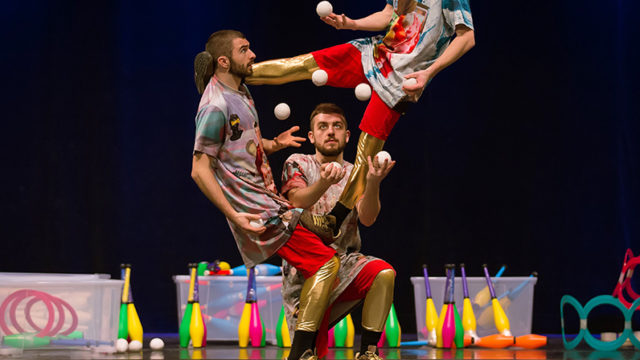Assembly Roxy, Edinburgh Festival Fringe; 5th July 2016

The seminal juggling extravaganza Water on Mars has been around in a variety of live and videoed incarnations since 2012, but the ‘waterboy’ dream-team of Patrik Elmnert, Tony Pezzo and Wes Peden has only chosen their company moniker, Plastic Boom, within the last few months. For Edinburgh audiences not privy to their underground celebrity, it’s the associated tag with previous international Fringe favourites Gandini Juggling that might draw the initial crowds. Soon though, it will be word of this show itself.
This colourful celebration is a pure display of extraordinary skill, presented in novel and entertaining ways. Costumed in a psychedelic fusion of hip-hop and rave wear, the three men variously enter the ring of multi-hued juggling props, where a donkey piñata waits for the party to begin. Their exquisite technical juggling talents are supplemented by a clear understanding of what looks impressive (the two don’t always go hand in hand), and Water on Mars offers sequences of pure aesthetic joy, interspersed with scenes of comedy or chaos.

There is no narrative arc and, if I were to extrapolate a theme, it would simply be ‘what things can we do with all this stuff’. The Stuff and the Things, however, are themselves by no means simple. The show is crowded with material, and the control of tightly synchronised throwing and passing patterns that we’re introduced to early on builds our confidence, allowing us to trust the disruption of expected routines later when bodies are restricted or constricted, traditional props give way to rolls of sellotape or toilet rolls, and the number of objects thrown is no indicator of the number that will be caught.
The Water on Mars title seems to be a container for the evolving skill vocabularies and artistic inspirations shared by the three performers. Over the course of the show, they slip between their focused-but-human selves and creatures of pure function, and there is an intensity to the juggling in the most strictly choreographed sections that requires this regular return to a level of pedestrian connection. The theatre craft of these transitional periods doesn’t always live up to the juggling craft either side, but they still provide a lightness that prevents the relentless patterning of objects through space becoming a complete bombardment. Like taking a water break every now and then at an all night dance club.
Non-performance audiences often ask theatre actors how they manage to remember all those lines. Here, the performers’ memories are filled with precise physical cues of time and space. As each pattern segues into another, I feel a simultaneous pang of loss and a new delight.

The bi-coloured clubs that separate and form newly hued arcs, the surprise at the properties of magnetic clubs joining together and being tested with a wiggle (which pre-empts the later joining of clubs, rings and bodies through copious use of sellotape), the interjection of a cloudy perspex tub between Pezzo’s body and red balls, and a procession of club tosses that allow for a whack at the piñata as each juggler passes are all separated with shifts in colour from the loops of string lighting that delineate the performance ring. Sound cuts are sudden and jerky, but the electro-rock tracks are well chosen, and the manipulations of objects in space are timed flawlessly to the musical phrasing.
The Water on Mars experience is a visual rush of sugared adrenaline with a happy awareness of its own frivolity and, when the water bottles come out at the end, we see that serious juggling can credibly cover the rock star base too.
.




